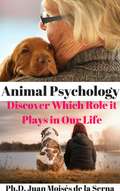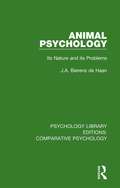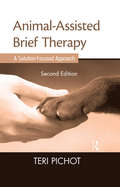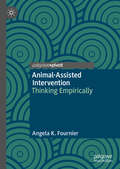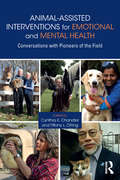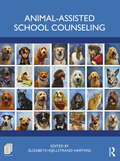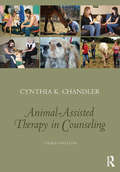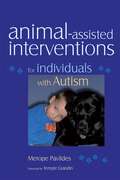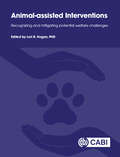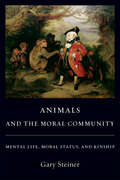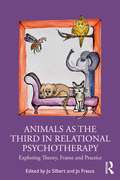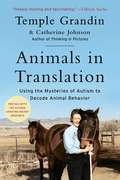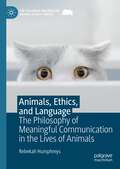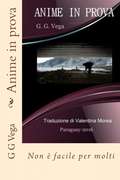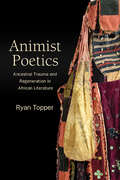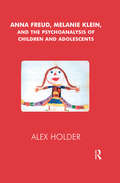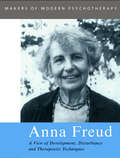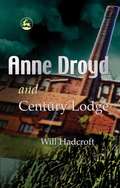- Table View
- List View
Animal Perception and Literary Language (Palgrave Studies in Animals and Literature)
by Donald WeslingAnimal Perception and Literary Language shows that the perceptual content of reading and writing derives from our embodied minds. Donald Wesling considers how humans, evolved from animals, have learned to code perception of movement into sentences and scenes. The book first specifies terms and questions in animal philosophy and surveys recent work on perception, then describes attributes of multispecies thinking and defines a tradition of writers in this lineage. Finally, the text concludes with literature coming into full focus in twelve case studies of varied readings. Overall, Wesling's book offers not a new method of literary criticism, but a reveal of what we all do with perceptual content when we read.
Animal Psychology - Discover which role it plays in our life
by Juan Moises de la Serna Julia Kräutler & Diego VelardeIn this book you will find an approach to the animal kingdom, from a psychological perspective, showing differences and similarities with humans. Likewise, it's commented about the actual experimental work in the search for diseases' cures and disorders' treatments. Finally, you will find an approach to animal-assisted therapy for various psychopathologies.
Animal Psychology: Its Nature and its Problems (Psychology Library Editions: Comparative Psychology)
by J.A. Bierens de HaanOriginally published in 1948, the author follows the idea that the instincts are "the spring and basis of all animal behaviour (with the exception perhaps of play), and therewith the core of the animal’s mind, and that individual experience, gathered by the animal in the course of its life, may influence and reconstruct these instincts, so as to guide, in the form of intelligence and understanding, this behaviour along new (i.e. innate) paths. Thus, instinct and experience become the pillars upon which animal behaviour is built up; instinct, intelligence, and understanding form a triad round which the facts of the psychology of animals may be grouped. As a foundation of all this the author first tries to prove the good right of a real and genuine animal psychology, not hampered by objectivistic and behaviouristic scruples, while in a final chapter, by way of conclusion, he tries to give an image of how the world of the animal is built up."
Animal and Human Conduct (Psychology Library Editions: Comparative Psychology)
by William E. RitterOriginally published in 1928, this title looks at the link between animal and human conduct. It had long been recognized on the basis of their activities that many animals possess minds, and that these are similar in a considerable number of respects to human minds. According to the author, this book looks at man’s position within nature from the perspective of a naturalist, rather than a psychologist or philosopher. He has attempted to describe the working of mind and body in human beings and in other living things; to examine critically the mental technique involved in such descriptions; and to reason broadly as to the bearings of the facts and processes on human life. Now it can be read and enjoyed in its historical context.
Animal-Assisted Brief Therapy: A Solution-Focused Approach
by Teri PichotThis book provides an overview of Animal-Assisted Activities (AAA) and Animal-Assisted Therapy (AAT) and demonstrates how they can be incorporated into solution-focused treatment programs. Pichot, focusing on the use of therapy dogs, starts with a discussion of the basics of AAA/T and solution-focused therapy, as well as what every practitioner should know about dogs before partnering with them. Successfully combining all of this into an effective treatment program is considered next. Pichot draws upon her own experience developing an AAA/T program in the substance abuse counseling program at a county public health agency to illustrate the effective implementation of such a program and the struggles and lessons learned in doing so. Using AAA/T with special populations, cultural considerations, and the impact a therapy dog can have on the handler. New in this edition are client scenarios that demonstrate the therapist’s thought process when making clinical decisions about when and how to use a therapy dog. Sample forms and treatment plans are also provided that professionals can use to modify or structure in their work with clients. The concepts and information provided in this valuable guide will be helpful for any therapist regardless of whether he or she is in private practice or working in an agency setting.
Animal-Assisted Intervention: Thinking Empirically
by Angela K. FournierThis book brings the animal into the scholarly discussion of animal-assisted therapy and other interventions. Challenging the current reliance on outcome studies, the author offers a new way of thinking empirically about animal-assisted interventions—analysis of human-animal interaction as a critical component. Through empirical demonstrations from laboratory and applied settings, the book encourages practitioners and scholars to undergo a deeper examination of the basic interactions that occur between clients or patients and therapy animals. Dr. Fournier provides new ideas on measurement, experimentation, and interpretation of human-animal interaction, aimed at identifying the role of the animal in interventions for human health and well-being.
Animal-Assisted Interventions for Emotional and Mental Health: Conversations with Pioneers of the Field
by Cynthia K. Chandler and Tiffany L. OttingAnimal-Assisted Interventions for Emotional and Mental Health provides a unique opportunity to learn from a variety of leaders in the field. Leading scholar Dr. Cynthia Chandler and colleague Dr. Tiffany Otting present interviews with pioneering experts from the U.S., U.K., Israel, India, and Hong Kong, revealing key beliefs, values, and ideas that are fundamental to animal-assisted interventions. Their words will inspire and guide current and future generations of practitioners, teachers, and researchers.
Animal-Assisted School Counseling
by Elizabeth Kjellstrand HartwigAnimal-Assisted School Counseling (AASC) is a hands-on resource that provides invaluable information for school counselors interested in partnering with a therapy animal on campus to help students meet social and emotional goals. This book presents a wealth of resources for school counselors and school-based mental health practitioners to incorporate animal partners on school campuses with individual students and groups and in classroom and schoolwide settings. Using the American School Counselor Association (ASCA)National Model framework, this book presents AASC interventions that can be implemented as part of the multitiered system of support to address students’ mental health needs. The text also meets the important demand for accountability in school counseling by providing resources for assessing the effectiveness of AASC interventions for meeting student and school outcome goals. Addressing such issues as getting school district buy-in, choosing an animal partner, preparing the school for an animal partner, theoretical applications of AASC, and student-affirming AASC services, the book is organized such that each chapter builds upon the next so school counselors understand what steps to take to become an effective AASC team. Ideal for the school counselor, social worker, or psychologist who may not have specific training in AASC, this book will encourage school mental health practitioners to seek out training programs to become an AASC team.
Animal-Assisted Therapy in Counseling
by Cynthia K. ChandlerThe third edition of Animal-Assisted Therapy in Counseling is the most comprehensive book available dedicated to training mental health practitioners in the performance of animal assisted therapy in counseling (AAT-C). New to this edition is discussion of the human-animal relational theory, a new theory dedicated to the practice of AAT-C. This edition also has added applications for supervision and includes the most recent research and practice. Consistent with previous editions, a variety of animal-assisted interventions are described with case examples provided in a variety of settings with different types of animals. This unique resource is an indispensable guide for any counselor or psychotherapist looking to develop and implement AAT techniques in practice.
Animal-Assisted Therapy in Counseling
by Cynthia K. ChandlerThe fourth edition of Animal-Assisted Therapy in Counseling is the most comprehensive book available dedicated to training mental health practitioners in the performance of animal-assisted therapy in counseling.This edition includes material on real-world animal-assisted interventions featuring counselor-client dialogues and sample therapeutic opportunities. Each chapter includes the most recent research and practice, and a wide variety of case examples present animal-assisted interventions in different settings with different types of animals.This unique resource is an indispensable guide for any counselor or psychotherapist looking to develop and implement animal-assisted therapy techniques in practice.
Animal-Assisted Therapy with Dogs: Basics, Animal Ethics and Practice of Therapeutic Work
by Katharina BleschAnimal-assisted therapy has been the talk of the town for several years and is increasingly being integrated into the psychotherapeutic treatment of people. But how exactly can dogs support psychotherapeutic work? How can animal welfare and human welfare be combined? Which dogs are suitable and how are they prepared? This book provides a practical and lively insight into therapeutic work with dogs. In addition to an overview of the basics as well as animal welfare and ethical aspects of dog-assisted therapy, concrete exercises in the context of dog-assisted self-confidence training are described pictorially and by video, providing inspiration for therapeutic work in various institutions and situations.
Animal-assisted Interventions for Individuals with Autism
by Temple Grandin Merope PavlidesThis book looks at how therapies involving animals can be used to help individuals with autism to develop skills, including sensory and social skills, to manage challenging behaviors, and improve quality of life. Whether participating in therapeutic horseback riding, utilizing a trained service dog, visiting a dolphin therapy center, or simply experiencing companion animal therapy, people with autism can reap a multitude of benefits from interaction with furry, feathered, and finned friends. Merope Pavlides relates the success stories of different animal-assisted interventions, as well as noting the challenges of working with particular animal species. She also emphasizes the importance of tailoring interventions to the specific needs of the individual and of monitoring progress. With recommendations for resources and further reading, this book will be of great interest to people with autism, their parents, and the professionals who work with them.
Animal-assisted Interventions: Recognizing and Mitigating Potential Welfare Challenges
by Temple Grandin Helen Lewis Amy Johnson Susan D. Greenbaum Ashley Thompson Aubrey H. Fine Veronica Lac Patti Anderson Nicky Barendrecht-Jenken Anna Van Berg Darlene Blackman Eileen Bona Donna Clarke Linda Chassman Craddock Yvonne Eaton-Stull Cynnie Foss Angela Fournier Megan French Nina Ekholm Fry Lisa-Maria Glenk Taylor Chastain Griffin Joy R. Hanson Terri Hlava Ann R. Howie Batya Gugenheim Jaffe Suzanne M. Kapral Jean Kirnan Ursula A. Kohl Elizabeth A. Letson Kirsty MacQueen Arieahn Matamonasa-Bennett Angela M. Moe Julie Ann Nettifee Zenithson Ng Brittany Panus Caiti Peters Laura Poleshuck Missy Reed Elizabeth Ruegg Brenda Rynders Sarah Schlote Shira Smilovici Risë VanFleet Melissa Y. Winkle Katrina WinsorThis is a practical book exploring how to conduct animal assisted intervention (AAI) in ways that protect and prioritize animal and human welfare. This resource is for social scientists (e.g., psychology, social work, human development and family studies, etc.), as well as ethologists and animal behaviour and welfare students and practitioners. The book is a series of short chapters that depict a wide array of AAIs and their potential welfare concerns. The chapters include descriptions of the AAI offered, the welfare challenges, and ways to successfully mitigate these challenges. This book also covers critical topics including therapy animals' aging, retirement, and death as well as ethical issues including animal consent. Species include not only dogs, but horses, rabbits, and other small animals (e.g., guinea pigs, mice, etc.). Types of AAI involve individual interventions as well as crisis dogs (those who help after natural and man-made disasters), and residential animals. The book is designed to be a practical, engaging book with links to video and examples of real-life situations. It is evidence-based, yet user-friendly and directly applicable to students and practitioners. This highly practical and engaging book with examples of real life situations, videos and case studies, explores how to conduct animal assisted interventions in ways that protect and prioritize animal and human welfare. The book: · Explores how to conduct animal assisted intervention (AAI) in ways that protect and prioritize animal and human welfare. · Discusses potential welfare challenges including how to advocate for the animal, animal consent, and the animal's aging, retirement, or death. · Evidence based approach to mitigating welfare concerns for a wide range of therapy animals including dogs, horses, rabbits, rodents, and exotic animals - and their recipients. An invaluable resource for ethologists and animal behaviour and welfare students and practitioners, as well as social scientists (e.g., psychology, social work, human development and family studies).
Animals and the Moral Community: Mental Life, Moral Status, and Kinship
by Gary SteinerGary Steiner argues that ethologists and philosophers in the analytic and continental traditions have largely failed to advance an adequate explanation of animal behavior. Critically engaging the positions of Marc Hauser, Daniel Dennett, Donald Davidson, John Searle, Martin Heidegger, and Hans-Georg Gadamer, among others, Steiner shows how the Western philosophical tradition has forced animals into human experiential categories in order to make sense of their cognitive abilities and moral status and how desperately we need a new approach to animal rights. <P><P>Steiner rejects the traditional assumption that a lack of formal rationality confers an inferior moral status on animals vis-à-vis human beings. Instead, he offers an associationist view of animal cognition in which animals grasp and adapt to their environments without employing concepts or intentionality. Steiner challenges the standard assumption of liberal individualism according to which humans have no obligations of justice toward animals. Instead, he advocates a "cosmic holism" that attributes a moral status to animals equivalent to that of people. Arguing for a relationship of justice between humans and nature, Steiner emphasizes our kinship with animals and the fundamental moral obligations entailed by this kinship.
Animals as the Third in Relational Psychotherapy: Exploring Theory, Frame and Practice
by Jo Silbert and Jo FrascaAnimals as the Third in Relational Psychotherapy: Exploring Theory, Frame and Practice elegantly and skilfully weaves together relevant literature, clinical reflections, compelling case material and contemporary psychoanalytic theory to demonstrate how the presence of an animal in the treatment arena can eventually bring about relational, interpersonal and intrapsychic change. Contemporary relational psychoanalytic literature has been virtually silent about our relationship with animals, a feature seemingly intrinsic to our relational worlds. This book seeks to remediate this void by giving voice to the practice and principles of working relationally in the presence of an animal. The text accentuates recurrent themes: animals are seen by human beings as significant subjective others and are treated as legitimate partners for relational and interpersonal processes, attachment figures and transferential objects; animals in the psychotherapy environment can play the role as a ‘bridge’ from the unconscious to the conscious, from the dissociated to the experienced, from the intrapsychic to the interpersonal; as the third in the treatment arena, the animal helps to reveal the field, bringing conflicts to life and making them available for analysis in the clinical setting. In seeking to authorise the incorporation of animals into the practice of relational psychotherapy the text applies conventional concepts to novel contexts; it extends psychoanalytic and relational principles to create a theoretical framework within which to consider the therapeutic effects of working in the triadic interactions of therapist, client and animal and thus also begins to evolve a new version of relational psychoanalytic practice. The authors value the human-animal experience in treatment and repeatedly show how the application of a relational psychoanalytic lens to the patient-therapist-animal triad can enhance the therapeutic process in ways that encourage progressive communication, understanding of the patient and the relaxing of defences, leading to the symbolising of relational capacity, therapeutic breakthrough and intrapsychic change.
Animals in Translation: Using the Mysteries of Autism to Decode Animal Behavior (Read-On)
by Catherine Johnson Temple GrandinWith unique personal insight, experience, and hard science, Animals in Translation is the definitive, groundbreaking work on animal behavior and psychology.Temple Grandin&’s professional training as an animal scientist and her history as a person with autism have given her a perspective like that of no other expert in the field of animal science. Grandin and coauthor Catherine Johnson present their powerful theory that autistic people can often think the way animals think—putting autistic people in the perfect position to translate &“animal talk.&” Exploring animal pain, fear, aggression, love, friendship, communication, learning, and even animal genius, Grandin is a faithful guide into their world. Animals in Translation reveals that animals are much smarter than anyone ever imagined, and Grandin, standing at the intersection of autism and animals, offers unparalleled observations and extraordinary ideas about both.
Animals, Empathy, and Anthropomorphism: The Limits of Imagination (The Palgrave Macmillan Animal Ethics Series)
by Carlo SalzaniThis open access book explores the role of imagination in animal ethics and its constitutive links to empathy/sympathy and anthropomorphism. The book argues for the constitutive role of imagination in ethical deliberation, but acknowledges that there exist important limits to its use. However, &“limit&” is here understood not merely negatively as restriction and insufficiency, but rather positively as &“condition of possibility,&” so what the book explores and analyses are the conditions for a positive and fruitful use of the imagination in ethics. The book uses as a &“frame&” the questions and issues raised in J.M. Coetzee&’s The Lives of Animals to explore some central and salient themes.
Animals, Ethics, and Language: The Philosophy of Meaningful Communication in the Lives of Animals (The Palgrave Macmillan Animal Ethics Series)
by Rebekah HumphreysWith an ever-growing body of evidence on the links between different oppressions, never have the debates in Critical Animal Studies surrounding intersectionality in relation to animal ethics been more important. In particular, the arguments related to anthropomorphic attributes of mentality to other than humans promise to provide fruitful new ground for re-assessing human-animal relations. This book maps the central debates surrounding anthropomorphism in relation to our descriptions of animals, their lives, animal mentality, and meaningful communication in the nonhuman world. Rebekah Humphreys synthesizes the work of critical animal theorists, philosophers, and cognitive ethologists, and provides a critical account of how the debates concerning anthropomorphism play a key role in a proper understanding of animal ethics.
Anime in prova
by Guido Galeano Vega Valentina MoreaIl libro Anime in prova è ispirato alla realtà che soffrono ogni giorno persone disagiate per le strade, sotto i ponti, vivendo come o peggio dei cani, mentre attorno esistono persone che avendo un eccesso di risorse, che potrebbero tender loro la mano, alzarli e aiutarli a rimettere in piedi le proprie vite, semplicemente li disprezza e li ignora. Nessuno sceglierebbe questo tipo di esperienza per se stesso, se si trovano li è perché le loro vite non sono state facili. Il proposito del libro è risvegliare la compassione che ogni essere umano possiede e deve possedere nella sua anima verso i propri simili caduti in disgrazia.
Animist Poetics: Ancestral Trauma and Regeneration in African Literature (SUNY series, Philosophy and Race)
by Ryan TopperArgues that African literature conceptualizes trauma and regeneration as a more-than-human process, offering an animist revision of psychoanalysis.Psychoanalytic trauma theory largely disregards African perspectives. Postcolonial criticism often filters these perspectives through a secular humanist lens. Examining how African literature uses animism to address the traumas of colonization, Animist Poetics offers a new understanding of the postcolonial condition. From an animist viewpoint, the self is not an individual but rather a regenerative process linking the living, the dead, and their ecosystems. Looking at poetry, fiction, drama, and visual art—including archival manuscripts by Wole Soyinka and Yvonne Vera—Ryan Topper argues that African literature reinvents these Indigenous ecologies in uniquely modern ways. Animist Poetics takes Indigenous—and literary—knowledge seriously, rethinking the foundations of psychoanalysis and charting new theoretical paths in posthumanism, the environmental humanities, new materialism, biopolitics, and memory studies.
Animus, Psyche and Culture: A Jungian Revision
by Sulagna SenguptaAnimus, Psyche and Culture takes Carl Jung’s concept of contra-sexual psyche and locates it within the cultural expanse of India, using ethnographic narratives, history, religion, myth, films, biographical extracts to deliberate on the feminine in psychological, social and archetypal realms. Jung’s concept of unconscious contra-sexuality, based on notions of feminine Eros and masculine Logos, was pioneering in his time, but took masculine and feminine to be fixed and essential attributes of gender in the psyche. This book explores the relevance of the animus, examining its rationale in current contexts of gender fluidity. Taking off from Post Jungian critiques, it proposes an exposition of the animus in history, social and religious phenomena, theories of knowledge, psychoid archetype and synchronicity, to grasp its nuances in diverse cultural worlds. This study re-envisions the notion of animus keeping in mind the intricacies of feminine subjectivity and the diversity of cultural worlds where depth psychological ideas are currently emerging. A remarkable reworking of Jungian ideas, this well-researched and important new book will be an insightful read for Jungian analysts and scholars with an interest in cultural and gender studies.
Anna Freud, Melanie Klein, and the Psychoanalysis of Children and Adolescents
by Alex HolderThe central theme of this book is concerned with the controversies on technique between Anna Freud and Melanie Klein in the 1920s and 1930s, and with a clear differentiation between child analysis proper and analytical child psychotherapy. Alex Holder takes into account the historic background in which child psychoanalysis developed, especially World War II and the Nazi regime in Germany. The author also looks at the way child psychoanalysis developed in specific institutions, such as the Hampstead Child Therapy Course in London, and in specific areas, such as the spread of child analysis in the US. The concluding chapter is on the importance of knowledge of child analysis among psychoanalysts working with adults. The differences in the theories of the two "greats" in child analysis, Anna Freud and Melanie Klein, are examined one by one, including such concepts as the role of transference, the Oedipus complex and the superego.
Anna Freud: A View of Development, Disturbance and Therapeutic Techniques (Makers of Modern Psychotherapy)
by Rose EdgcumbeAnna Freud, daughter of Sigmund, made many original contributions to psychoanalytic theory and child development, and yet much of her work remains relatively unknown. In this book, Rose Edgcumbe seeks to redress the situation. Taking a fresh look at Anna Freud's theories and techniques from a clinical and critical viewpoint, and the controversy they caused, she highlights how Anna Freud's work is still relevant and important to the problems of today's society, such as dysfunctional families, child delinquency and violence. It also plays a vital role in recent developments in therapeutic techniques. Written by a former student and co-worker of Anna Freud, this book will make useful reading for clinicians and students of child development. Rose Edgcumbe is a member of the Association of Child Psychotherapists and the British Psychoanalytic Society. Since training with Anna Freud at the Hampstead Clinic she has worked there in many capacities in treatment, training and reseach, and in other clinics. She has published numerous papers on child analysis, including a memorial paper: Anna Freud: Child Analyst.
Annals of an Abiding Liberal
by John Kenneth Galbraith Andrea D. WilliamsAddresses, essays, lectures on economic policy, economic affairs, Galbraith's personal history, several authors, and the arts - a mixed bag by the famous economist.
Anne Droyd and Century Lodge
by William HadcroftGezz and her best friends Malcolm and Luke are having fun on the housing estate where they live when the arrival of a stranger interrupts their everyday lives and changes the world as they know it forever. Created by a professor of robotics, Anne Droyd is left in the care of these three children, who take her to school with them and teach her how to be 'a human'. This imaginative tale packed full of heroic characters and Asperger adventure is suitable for children aged 9 and over.

